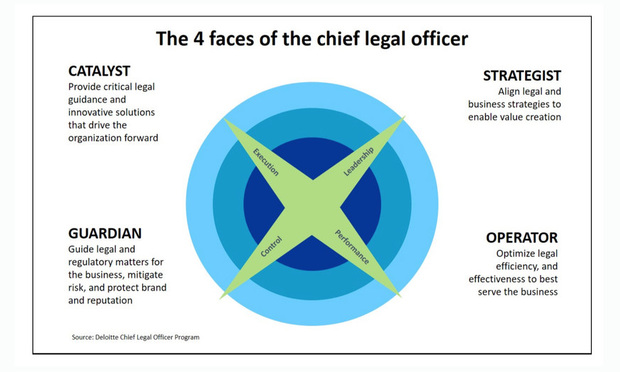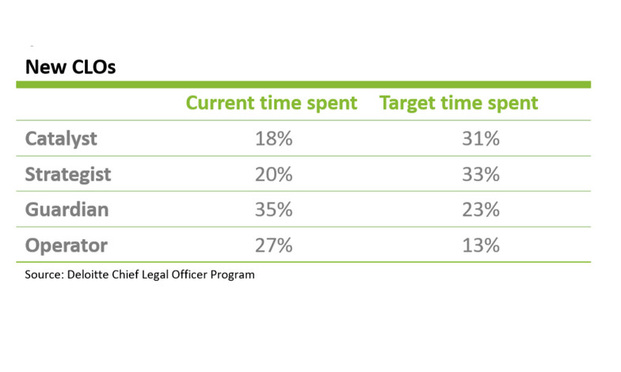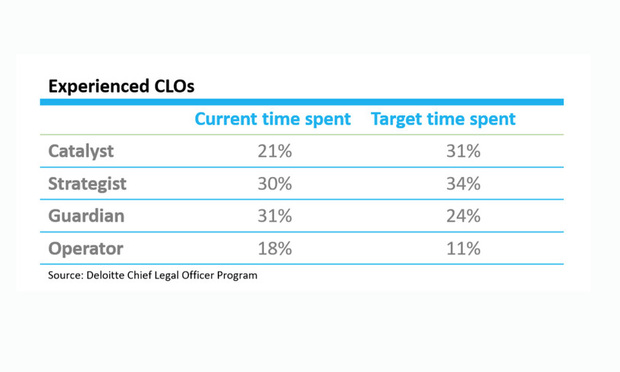Which Face Does Your Chief Legal Officer Wear Most?
As CLOs increasingly report directly to CEOs, how can they balance legal and strategic demands on their time
June 19, 2019 at 04:30 PM
5 minute read
 Getty Images/iStockphoto
Getty Images/iStockphoto
The role of today's chief legal officer (CLO) has evolved into that of both a strategic contributor and senior executive. In fact, the ACC Chief Legal Officers 2019 Survey found that 78% of U.S. CLOs and 93% of Fortune 500 CLOs report directly to their company's top executive. Further, over 75% provide input on business decisions to executive leaders including the CEO and board.
But as expectations for CLOs ratchet up, how can those legal leaders be successful balancing necessary team management work with the need to meet and exceed responsibilities at the leadership table? Dividing time between “four faces”—guardian, operator, catalyst and strategist—may help.

The Four Faces of the CLO
Guardian: In the guardian role, CLOs focus most on defense of the business—the foundational responsibility for corporate counsel. They guide legal and regulatory matters for the business, mitigating often risks like those in corporate integrity, brand and reputation and governance.
Operator: As operators, CLOs focus on optimizing the talent, capabilities, service levels, costs and legal structure needed to best serve the business. For the in-house counsel team, the CLO as operator fosters professional development programs, identifies and remedies subject matter expertise and technology gaps and improves effectiveness of the legal operating model. With outside counsel, the CLO as an operator develops and implements performance metrics, while also forecasting and reporting on legal spend.
Catalyst: When CLOs act as catalysts, they challenge the status quo as a change agent highly focused on helping executive leadership select the right path forward. To do so, CLOs as catalysts focus on enabling competitive advantage via critical legal guidance by assessing business practices and then building or strengthening areas of the organization including its risk profile, compliance framework and corporate culture.
Strategist: As a strategist, CLOs can help align clear a legal strategy that supports business strategy and enables value creation. Beyond building strong relationships with leadership teams and board members, CLOs as strategists understand business strategy and value creation leavers as well as changes in regulatory requirements and public policy, reflecting them all in legal strategy.
The Time Allocation Challenge
Deloitte interviews with executive leaders indicate that most CEOs and boards want the full C-suite to spend the majority of their time—about 60% to 70% — on catalyst and strategist work, with just 30 to 40% in the guardian and operator roles.
However, many new CLOs have told us that their time allocation is often the reverse of CEO and board requests.

Even experienced CLOs sometimes find it difficult to align their time allocation to meet the expectations of the CEO and board. However, the difference between new and experienced CLOs seems to be the ability to spend less time on operator work and contribute more to strategist work.

It's important to note that while experienced CLOs we interviewed want to spend more time than new CLOs on catalyst and strategist work, both new and experienced CLOs we spoke to wanted to allocate more time to their catalyst and strategist roles.
Tackling the Time Crunch by Prioritizing Talent
Shifting a new or experienced CLO's time into more strategist and catalyst work takes prioritization of legal operations. If an organization doesn't already have a strong legal operations leader in place to manage guardian and operator work, finding one should take top priority. The top regret we've heard from new CLOs around their first anniversary in-role is that they didn't make talent decisions sooner, neglecting to put the right people in the right roles, reorganizing the team, or separating individuals who are difficult or have skills that aren't aligned to department needs.
Not all CLOs are interested in transitioning away from guardian and operator roles, as they've become comfortable in those roles and well rewarded for them over time. But the failure to transition can be interpreted by the rest of the C-suite as an inability to contribute on a strategic, executive level. A successful transition, however, creates opportunities for competitive advantage—both for the business and the legal leader.
Lori Lorenzo is managing director at Deloitte Transactions and Business Analytics LLP and leader of Deloitte's chief legal officer program, focusing on how general counsel and legal teams can elevate their careers.
This content has been archived. It is available through our partners, LexisNexis® and Bloomberg Law.
To view this content, please continue to their sites.
Not a Lexis Subscriber?
Subscribe Now
Not a Bloomberg Law Subscriber?
Subscribe Now
NOT FOR REPRINT
© 2025 ALM Global, LLC, All Rights Reserved. Request academic re-use from www.copyright.com. All other uses, submit a request to [email protected]. For more information visit Asset & Logo Licensing.
You Might Like
View All
AI Disclosures Under the Spotlight: SEC Expectations for Year-End Filings
5 minute read
A Blueprint for Targeted Enhancements to Corporate Compliance Programs
7 minute read

Three Legal Technology Trends That Can Maximize Legal Team Efficiency and Productivity
Trending Stories
- 1Judge Receives Supreme Court Reprimand: 'Your Behavior Was Unacceptable'
- 2Contracts Game Changer? One-Sided ADR Provision Overturned
- 3Attorney Says Seeking Justice for Inmate's Death Requires Systemic Change as Well as Compensation
- 4Justice 'Weaponization Working Group' Will Examine Officials Who Investigated Trump, US AG Bondi Says
- 5Judge Accuses Trump of Constitutional End Run, Blocks Citizenship Order
Who Got The Work
J. Brugh Lower of Gibbons has entered an appearance for industrial equipment supplier Devco Corporation in a pending trademark infringement lawsuit. The suit, accusing the defendant of selling knock-off Graco products, was filed Dec. 18 in New Jersey District Court by Rivkin Radler on behalf of Graco Inc. and Graco Minnesota. The case, assigned to U.S. District Judge Zahid N. Quraishi, is 3:24-cv-11294, Graco Inc. et al v. Devco Corporation.
Who Got The Work
Rebecca Maller-Stein and Kent A. Yalowitz of Arnold & Porter Kaye Scholer have entered their appearances for Hanaco Venture Capital and its executives, Lior Prosor and David Frankel, in a pending securities lawsuit. The action, filed on Dec. 24 in New York Southern District Court by Zell, Aron & Co. on behalf of Goldeneye Advisors, accuses the defendants of negligently and fraudulently managing the plaintiff's $1 million investment. The case, assigned to U.S. District Judge Vernon S. Broderick, is 1:24-cv-09918, Goldeneye Advisors, LLC v. Hanaco Venture Capital, Ltd. et al.
Who Got The Work
Attorneys from A&O Shearman has stepped in as defense counsel for Toronto-Dominion Bank and other defendants in a pending securities class action. The suit, filed Dec. 11 in New York Southern District Court by Bleichmar Fonti & Auld, accuses the defendants of concealing the bank's 'pervasive' deficiencies in regards to its compliance with the Bank Secrecy Act and the quality of its anti-money laundering controls. The case, assigned to U.S. District Judge Arun Subramanian, is 1:24-cv-09445, Gonzalez v. The Toronto-Dominion Bank et al.
Who Got The Work
Crown Castle International, a Pennsylvania company providing shared communications infrastructure, has turned to Luke D. Wolf of Gordon Rees Scully Mansukhani to fend off a pending breach-of-contract lawsuit. The court action, filed Nov. 25 in Michigan Eastern District Court by Hooper Hathaway PC on behalf of The Town Residences LLC, accuses Crown Castle of failing to transfer approximately $30,000 in utility payments from T-Mobile in breach of a roof-top lease and assignment agreement. The case, assigned to U.S. District Judge Susan K. Declercq, is 2:24-cv-13131, The Town Residences LLC v. T-Mobile US, Inc. et al.
Who Got The Work
Wilfred P. Coronato and Daniel M. Schwartz of McCarter & English have stepped in as defense counsel to Electrolux Home Products Inc. in a pending product liability lawsuit. The court action, filed Nov. 26 in New York Eastern District Court by Poulos Lopiccolo PC and Nagel Rice LLP on behalf of David Stern, alleges that the defendant's refrigerators’ drawers and shelving repeatedly break and fall apart within months after purchase. The case, assigned to U.S. District Judge Joan M. Azrack, is 2:24-cv-08204, Stern v. Electrolux Home Products, Inc.
Featured Firms
Law Offices of Gary Martin Hays & Associates, P.C.
(470) 294-1674
Law Offices of Mark E. Salomone
(857) 444-6468
Smith & Hassler
(713) 739-1250






